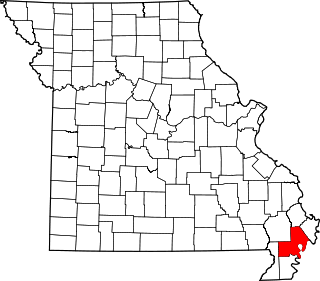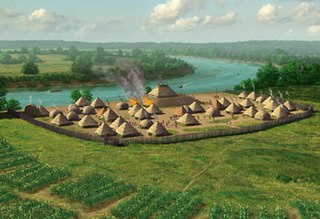
Fort Ancient is a name for a Native American culture that flourished from c. 1000–1750 CE and predominantly inhabited land near the Ohio River valley in the areas of modern-day southern Ohio, northern Kentucky, southeastern Indiana and western West Virginia. Although a contemporary of the Mississippian culture, they are often considered a "sister culture" and distinguished from the Mississippian culture. While far from agreed upon, there is evidence to suggest that the Fort Ancient Culture were not the direct descendants of the Hopewellian Culture. It is suspected that the Fort Ancient Culture introduced maize agriculture to Ohio. The Fort Ancient Culture were most likely the builders of the Great Serpent Mound. Recent archeological study and carbon dating suggests that Alligator Mound in Granville also dates to the Fort Ancient era, rather than the assumed Hopewell era. It is believed that neither the Serpent or Alligator Mounds are burial locations, but rather served as ceremonial effigy sites.

The Mississippian culture was a Native American civilization that flourished in what is now the Midwestern, Eastern, and Southeastern United States from approximately 800 CE to 1600 CE, varying regionally. It was known for building large, earthen platform mounds, and often other shaped mounds as well. It was composed of a series of urban settlements and satellite villages linked together by loose trading networks. The largest city was Cahokia, believed to be a major religious center located in what is present-day southern Illinois.

Wickliffe Mounds is a prehistoric, Mississippian culture archaeological site located in Ballard County, Kentucky, just outside the town of Wickliffe, about 3 miles (4.8 km) from the confluence of the Ohio and Mississippi rivers. Archaeological investigations have linked the site with others along the Ohio River in Illinois and Kentucky as part of the Angel phase of Mississippian culture. Wickliffe Mounds is controlled by the State Parks Service, which operates a museum at the site for interpretation of the ancient community. Listed on the National Register of Historic Places, it is also a Kentucky Archeological Landmark and State Historic Site.

Caborn-Welborn was a precontact and proto-historic North American culture defined by archaeologists as a Late Mississippian cultural manifestation that grew out of – or built upon the demise of – the Angel chiefdom located in present-day southern Indiana. Caborn-Welborn developed around 1400 and seems to have disappeared around 1700 CE. The Caborn-Welborn culture was the last Native American occupation of southern Indiana prior to European contact. It remains unclear which post-contact Native group, if any, are their descendants.
The Angel phase describes a 300–400-year cultural manifestation of the Mississippian culture of the central portions of the United States of America, as defined in the discipline of archaeology. Angel phase archaeological sites date from c. 1050 - 1350 CE and are located on the northern and southern sides of the Ohio River in southern Indiana, such as National Historic Landmark Angel Mounds near present-day Evansville; northwestern Kentucky, with Wickliffe Mounds and the Tolu Site; and Kincaid Mounds State Historic Site in Illinois. Additional sites range from the mouth of Anderson River in Perry County, Indiana, west to the mouth of the Wabash in Posey County, Indiana.

Coles Creek culture is a Late Woodland archaeological culture in the Lower Mississippi valley in the Southeastern Woodlands. It followed the Troyville culture. The period marks a significant change in the cultural history of the area. Population increased dramatically and there is strong evidence of a growing cultural and political complexity, especially by the end of the Coles Creek sequence. Although many of the classic traits of chiefdom societies are not yet manifested, by 1000 CE the formation of simple elite polities had begun. Coles Creek sites are found in Arkansas, Louisiana, and Mississippi. It is considered ancestral to the Plaquemine culture.

The Plaquemine culture was an archaeological culture centered on the Lower Mississippi River valley. It had a deep history in the area stretching back through the earlier Coles Creek and Troyville cultures to the Marksville culture. The Natchez and related Taensa peoples were their historic period descendants. The type site for the culture is the Medora site in Louisiana; while other examples include the Anna, Emerald, Holly Bluff, and Winterville sites in Mississippi.

This is a list of the National Register of Historic Places listings in Fulton County, Kentucky.
The Hardin Village site (15GP22) is a Fort Ancient culture Montour Phase archaeological site located on a terrace of the Ohio River near South Shore in Greenup County, Kentucky. It is located within the Big Sandy Management Area along with the nearby Lower Shawneetown site. The site was first inhabited sometime in the early 16th century and abandoned by 1625. This era of protohistory saw the arrival of Europeans in North America, although by the time they made it to this area, the village had been long abandoned.

The Twin Mounds Site, also known as the Nolan Site, is a Mississippian culture archaeological site located near Barlow in Ballard County, Kentucky, just north of the confluence of the Ohio and Mississippi Rivers, and directly across the Ohio River from Mound City, Illinois.

The Marshall Site (15CE27) is an Early Mississippian culture archaeological site located near Bardwell in Carlisle County, Kentucky, on a bluff spur overlooking the Mississippi River floodplain. The site was occupied from about 900 to about 1300 CE during the James Bayou Phase of the local chronology and was abandoned sometime during the succeeding Dorena Phase. Its inhabitants may have moved to the Turk Site, which is located on the nearest adjacent bluff spur to the south, and which was founded about this time. It is several miles south of the Wickliffe Mounds Site.

The Rowlandton Mound Site (15MCN3) is a Mississippian culture archaeological site located in Paducah in McCracken County, Kentucky, on the edge of an old oxbow lake a little south of the Ohio River.

The Adams site (15FU4) is a Mississippian culture archaeological site located near Hickman in Fulton County, Kentucky, on Bayou de Chien, a creek that drains into the nearby Mississippi River.
The Bentley site (15Gp15) is a Late Fort Ancient culture Madisonville horizon archaeological site overlain by an 18th-century Shawnee village; it is located within the Lower Shawneetown Archeological District, near South Portsmouth in Greenup County, Kentucky and Lewis County, Kentucky. It was added to the National Register of Historic Places on April 28, 1983. It is located near four groups of Hopewell tradition mounds, built between 100 BCE and 500 CE, known as the Portsmouth Earthworks.
The Muir site, (15JS86), is an Early Fort Ancient culture archaeological site located in Jessamine County, Kentucky, in the Bluegrass region of the state. It was occupied from about 1010 to 1255 CE during the Osborne Phase of the local chronology. The site is near Jessamine Creek, on top of a broad ridge. Unlike later Fort Ancient villages, which are more compact, the Muir site structures were spread out over the ridge top. These structures were rectangular with single set post construction, as opposed to Mississippian style wall trench construction. Within the houses were 30 centimetres (12 in) to 50 centimetres (20 in) deep floor basins with centrally located hearths for cooking and heating. Pottery found at the Muir site was limestone-tempered, unlike some later Fort Ancient pottery which became mussel shell tempered after contact with Mississippian cultures.

This is a list of the National Register of Historic Places listings in New Madrid County, Missouri.

The Annis Mound and Village site is a prehistoric Middle Mississippian culture archaeological site located on the bank of the Green River in Butler County, Kentucky, several miles northwest of Morgantown in the Big Bend region. It was occupied from about 800 CE to about 1300 CE.
The Starr Village and Mound Group (11MP3), is a Mississippian culture archaeological site located on a bluff overlooking Macoupin Creek southwest of Carlinville in Macoupin County, Illinois.













